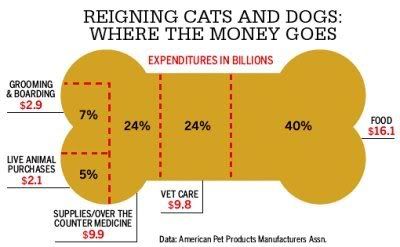
Americans now spend $41 billion a year on their pets—more than the gross domestic product of all but 64 countries in the world. That's double the amount shelled out on pets a decade ago, with annual spending expected to hit $52 billion in the next two years. That puts the yearly cost of buying, feeding, and caring for pets in excess of what Americans spend on the movies ($10.8 billion), playing video games ($11.6 billion), and listening to recorded music ($10.6 billion) combined.
42% of dogs now sleep in the same bed as their owners, up from 34% in 1998. Their menu reflects every fad in human food—from locally sourced organic meat and vegan snacks to gourmet meals bolstered by, say, glucosamine to ward off stiff joints. Half of all dog owners say they consider their pet's comfort when buying a car, and almost a third buy gifts for their dogs' birthdays. About 77% of dogs and 52% of cats have been medicated in the past year, an increase of about 20 percentage points from 1996.
About 63% of U.S. households, or 71 million homes, now own at least one pet, up from 64 million just five years ago. After consumer electronics, pet care is the fastest-growing category in retail, expanding about 6% a year. More new pet products were launched in the first six months of last year than in all of 2005.
Pet products now aim to make people feel they're being extra good to their little ones—much as toy makers have long encouraged parents to spoil kids. Along with doggie spas, there are mobile pet-grooming vans, pedicure services, professional dog walkers, and massage therapy for animals. And for some pet lovers, no medical procedure is too extreme. Plastic surgeons offer rhinoplasty, eye lifts, and other cosmetic procedures to help tone down certain doggy features, from droopy eyes to puggish noses. Root canals, braces, and even crowns for chipped teeth are also becoming more popular.
